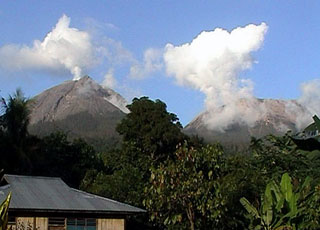Report on Lewotobi (Indonesia) — 27 December-2 January 2024
Smithsonian Institution / US Geological Survey
Weekly Volcanic Activity Report, 27 December-2 January 2024
Managing Editor: Sally Sennert.
Please cite this report as:
Global Volcanism Program, 2023. Report on Lewotobi (Indonesia) (Sennert, S, ed.). Weekly Volcanic Activity Report, 27 December-2 January 2024. Smithsonian Institution and US Geological Survey.
Lewotobi
Indonesia
8.542°S, 122.775°E; summit elev. 1703 m
All times are local (unless otherwise noted)
PVMBG reported that seismicity at Lewotobi had increased on 12 December and was followed by the emergence of “tornillo” earthquakes indicating fluid movement at depth. An eruption occurred on 23 December at Laki-laki and lasted about 24 minutes. A 160-m-long fissure on the upper NW flank was visible afterwards and it emitted dense white plumes that rose 300 m. At 0253 on 28 December an observer noted a dense white-and-gray ash plume that rose 1 km above the summit and drifted NW. On 1 January the amplitude of continuous tremors increased. A new vent opened along a fissure located on the upper SSE flank and produced a white, gray, and black ash plume that rose 1-1.5 km above the summit. The Alert Level was raised to 3 (on a scale of 1-4) at 1600 and the public was warned to stay 3 km away from the Perempuan and Laki-laki craters and an additional 4 km from the NNW and SSE flanks of Laki-laki. At 0454 on 2 January a gray-to-brown ash plume rose 1.5 km above the summit and drifted SW and W.
Geological Summary. The Lewotobi edifice in eastern Flores Island is composed of the two adjacent Lewotobi Laki-laki and Lewotobi Perempuan stratovolcanoes (the "husband and wife"). Their summits are less than 2 km apart along a NW-SE line. The conical Laki-laki to the NW has been frequently active during the 19th and 20th centuries, while the taller and broader Perempuan has had observed eruptions in 1921 and 1935. Small lava domes have grown during the 20th century in both of the summit craters, which are open to the north. A prominent cone, Iliwokar, occurs on the E flank of Perampuan.
Source: Pusat Vulkanologi dan Mitigasi Bencana Geologi (PVMBG, also known as CVGHM)

